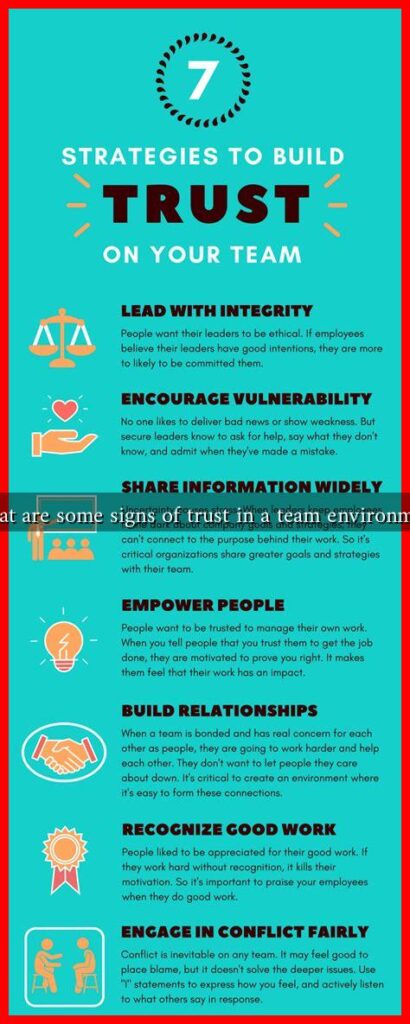-
Table of Contents
What are Some Signs of Trust in a Team Environment
Trust is the cornerstone of any successful team. It fosters collaboration, enhances communication, and drives productivity. In a team environment, trust can manifest in various ways, and recognizing these signs can help leaders and team members cultivate a more cohesive and effective workplace. This article explores the key indicators of trust within a team, supported by research and real-world examples.
Open Communication
One of the most significant signs of trust in a team is open communication. When team members feel comfortable sharing their thoughts, ideas, and concerns without fear of judgment, it indicates a high level of trust. Open communication can be observed through:
- Active Listening: Team members listen to each other attentively, valuing each other’s opinions.
- Constructive Feedback: Feedback is given and received positively, focusing on growth rather than criticism.
- Transparency: Team members share information openly, ensuring everyone is on the same page.
A study by the Forbes Human Resources Council highlights that organizations with open communication are 25% more likely to have lower employee turnover rates. This statistic underscores the importance of fostering an environment where team members feel safe to express themselves.
Collaboration and Support
Trust is also evident in the way team members collaborate and support one another. When individuals are willing to help each other and work together towards common goals, it reflects a strong foundation of trust. Signs of collaboration and support include:
- Shared Goals: Team members align their objectives and work towards achieving them collectively.
- Willingness to Help: Team members readily offer assistance to one another, demonstrating a commitment to each other’s success.
- Celebrating Successes: The team acknowledges and celebrates both individual and collective achievements.
For instance, a case study involving Google’s Project Aristotle revealed that psychological safety—where team members feel safe to take risks and be vulnerable—was a key factor in high-performing teams. This environment of collaboration and support led to increased innovation and productivity.
Accountability and Reliability
Another critical sign of trust in a team is accountability. When team members hold themselves and each other accountable for their actions and responsibilities, it fosters a sense of reliability. Key indicators of accountability include:
- Meeting Deadlines: Team members consistently deliver their work on time, demonstrating reliability.
- Owning Mistakes: Individuals take responsibility for their errors and learn from them rather than shifting blame.
- Consistent Performance: Team members maintain a high level of performance, reinforcing trust in their capabilities.
A survey conducted by the Harvard Business Review found that teams with high accountability levels are 50% more likely to achieve their goals. This statistic highlights the importance of accountability in building trust within a team.
Mutual Respect and Empathy
Trust is deeply rooted in mutual respect and empathy among team members. When individuals respect each other’s perspectives and show empathy towards one another, it creates a supportive environment. Signs of mutual respect and empathy include:
- Valuing Diversity: Team members appreciate and leverage diverse backgrounds and viewpoints.
- Emotional Support: Individuals offer emotional support during challenging times, fostering a sense of belonging.
- Conflict Resolution: Team members address conflicts constructively, focusing on solutions rather than personal attacks.
Research from the Gallup Organization indicates that teams with high levels of respect and empathy experience 21% greater profitability. This statistic emphasizes the financial benefits of fostering a respectful and empathetic team culture.
Conclusion
In conclusion, trust is an essential element of a successful team environment. Recognizing the signs of trust—such as open communication, collaboration and support, accountability, and mutual respect—can help leaders and team members create a more cohesive and productive workplace. By fostering these signs of trust, teams can enhance their performance, drive innovation, and achieve their goals more effectively. Building trust takes time and effort, but the rewards are well worth it.

